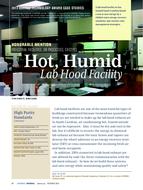In both compression refrigeration and two-pressure absorption refrigeration, it is necessary to change low-pressure refrigerant vapor which leaves the evaporator to high-pressure vapor before it enters the condenser. In the former, vapor is pressurized directly. In the latter, vapor is converted through an absorption operation to a liquid phase which is much smaller in volume and this liquid is pressurized. The operation may be thought of as a technique for reducing volume in order to reduce the work of pressurizing. Characteristics of the operation playa key role in the cost and efficiency of absorption refrigeration, particularly for the ammonia-water system.
In this paper some of the characteristics of three flow patterns for the vapor and absorbing liquid, concurrent, crosscurrent, and countercurrent, will be presented with the aid of a sample calculation based on the simpie heat-transfer model. In each case it will be assumed that the flow of the coolant is countercurrent to that of the absorbing liquid.
Citation: ASHRAE Transactions, Volume 77, Part 1, Philadelphia, PA
Product Details
- Published:
- 1971
- Number of Pages:
- 5
- File Size:
- 1 file , 400 KB
- Product Code(s):
- D-PH-2184


